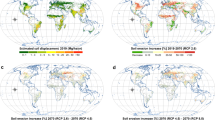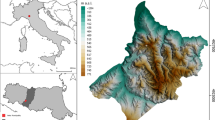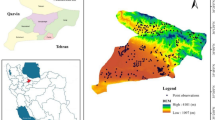Abstract
Soil erosion is a serious threat to soil functions leading to land productivity decline and multiple off-site effects. Here we show, using a multi-model approach, the spatial risk of soil erosion by water, wind, tillage and harvesting and where the co-occurrence of these different processes is observed. Moreover, we analysed where these locations of multiple erosion co-occurrence are likely to intersect with the projected increase of dry/wet climate conditions. Of the ~110 million hectares (M ha) of arable land in the European Union, our estimates show that 43 M ha are vulnerable to a single driver of erosion, 15.6 M ha to two drivers and 0.81 M ha to three or more drivers. About 3.2 M ha of arable land are vulnerable to the possible interaction of increased flood, drought, water and wind erosion. We contend that this set of predictions serves as a basis for developing an efficient stratified monitoring network and informing targeted mitigation strategies under the Common Agricultural Policy 2023–2027. The road to the sustainable, carbon-neutral and biodiversity-friendly system of agriculture advocated for in the EU Green Deal goes through a thematic strategy for soil protection from multiple concurrent erosion processes.
This is a preview of subscription content, access via your institution
Access options
Access Nature and 54 other Nature Portfolio journals
Get Nature+, our best-value online-access subscription
$29.99 / 30 days
cancel any time
Subscribe to this journal
Receive 12 digital issues and online access to articles
$119.00 per year
only $9.92 per issue
Buy this article
- Purchase on Springer Link
- Instant access to full article PDF
Prices may be subject to local taxes which are calculated during checkout



Similar content being viewed by others
Data availability
All data supporting the findings of this study are available within the article text and Supplementary Information or are freely available at the European Soil Data Centre (ESDAC), the institutional soil data repository of the European Commission Joint Research Centre (https://esdac.jrc.ec.europa.eu/). Additional higher-resolution maps (GeoTIFF format) will be made available via ESDAC.
Code availability
Code and programmes can be retrieved from the European Soil Data Centre (ESDAC) (https://esdac.jrc.ec.europa.eu/) and from the corresponding author upon reasonable request.
References
Robinson, D. A. et al. Soil natural capital in Europe; a framework for state and change assessment. Sci. Rep. 7, 6706 (2017).
Keesstra, S. D. et al. The significance of soils and soil science towards realization of the United Nations Sustainable Development Goals. SOIL 2, 111–128 (2016).
Borrelli, P. et al. Soil erosion modelling: a global review and statistical analysis. Sci. Total Environ. 780, 146494 (2021).
Poesen, J. Soil erosion in the Anthropocene: research needs. Earth Surf. Processes Landforms 84, 64–84 (2018).
Verheijen, F. G. A., Jones, R. J. A., Rickson, R. J. & Smith, C. J. Tolerable versus actual soil erosion rates in Europe. Earth Sci. Rev. 94, 23–38 (2009).
Borrelli, P. et al. Monitoring gully erosion in the European Union: a novel approach based on the Land Use/Cover Area frame Survey (LUCAS). Int. Soil Water Conserv. Res. 10, 17–28 (2021).
The Common Agricultural Policy at a Glance (European Commission, 2022); https://ec.europa.eu/info/food-farming-fisheries/key-policies/common-agricultural-policy/cap-glance_en
Silva, V. et al. Distribution of glyphosate and aminomethylphosphonic acid (AMPA) in agricultural topsoils of the European Union. Sci. Total Environ. 621, 1352–1359 (2018).
Healthy Soils–New EU Soil Strategy (European Commission, 2022); https://ec.europa.eu/info/law/better-regulation/have-your-say/initiatives/12634-Healthy-soils-new-EU-soil-strategy_en
Schebesta, H. & Candel, J. J. L. Game-changing potential of the EU’s farm to fork strategy. Nat. Food 1, 586–588 (2020).
Christel, A., Maron, P. A. & Ranjard, L. Impact of farming systems on soil ecological quality: a meta-analysis. Environ. Chem. Lett. 19, 4603–4625 (2021).
Claassen, R. et al. Tillage Intensity and Conservation Cropping in the United States (USDA Economic Research Service, 2018).
Borrelli, P. et al. Land use and climate change impacts on global soil erosion by water (2015–2070). Proc. Natl Acad. Sci. USA 117, 21994–22001 (2020).
Stroosnijder, L. Measurement of erosion: is it possible? Catena 64, 162–173 (2005).
Hu, L.-J. & Flanagan, D. C. Towards new-generation soil erosion modeling: building a unified omnivorous model. J. Soil Water Conserv. 68, 100A–103A (2013).
Boardman, J. & Evans, R. The measurement, estimation and monitoring of soil erosion by runoff at the field scale: challenges and possibilities with particular reference to Britain. Prog. Phys. Geogr. 44, 31–49 (2020).
Fick, S. E. & Hijmans, R. J. WorldClim 2: new 1-km spatial resolution climate surfaces for global land areas. Int. J. Climatol. 37, 4302–4315 (2017).
Panagos, P. et al. The new assessment of soil loss by water erosion in Europe. Environ. Sci. Policy 54, 438–447 (2015).
Van Oost, K., Cerdan, O. & Quine, T. A. Accelerated sediment fluxes by water and tillage erosion on European agricultural land. Earth Surf. Process. Landf. 34, 1625–1634 (2009).
Borrelli, P., Lugato, E., Montanarella, L. & Panagos, P. A new assessment of soil loss due to wind erosion in European agricultural soils using a quantitative spatially distributed modelling approach. L. Degrad. Dev. 28, 335–344 (2017).
Panagos, P., Borrelli, P. & Poesen, J. Soil loss due to crop harvesting in the European Union: a first estimation of an underrated geomorphic process. Sci. Total Environ. 664, 487–498 (2019).
Bryan, R. B. Soil erodibility and processes of water erosion on hillslope. Geomorphology 32, 385–415 (2000).
Nearing, M. A., Yin, S.-Q., Borrelli, P. & Polyakov, V. O. Rainfall erosivity: an historical review. Catena 157, 357–362 (2017).
Panagos, P., Borrelli, P. & Meusburger, K. A new European slope length and steepness factor (LS-factor) for modeling soil erosion by water. Geosciences 5, 117–126 (2015).
Panagos, P. et al. Estimating the soil erosion cover-management factor at the European scale. Land Use Policy 48, 38–50 (2015).
Panagos, P. et al. Rainfall erosivity in Europe. Sci. Total Environ. 511, 801–814 (2015).
Panagos, P., Meusburger, K., Ballabio, C., Borrelli, P. & Alewell, C. Soil erodibility in Europe: a high-resolution dataset based on LUCAS. Sci. Total Environ. 479–480, 189–200 (2014).
Panagos, P. et al. Modelling the effect of support practices (P-factor) on the reduction of soil erosion by water at European scale. Environ. Sci. Policy 51, 23–34 (2015).
Lindstrom, M. J., Nelson, W. W. & Schumacher, T. E. Quantifying tillage erosion rates due to moldboard plowing. Soil Tillage Res. 24, 243–255 (1992).
Govers, G., Vandaele, K., Desmet, P., Poesen, J. & Bunte, K. The role of tillage in soil redistribution on hillslopes. Eur. J. Soil Sci. 45, 469–478 (1994).
Van Oost, K., Govers, G., de Alba, S. & Quine, T. A. Tillage erosion: a review of controlling factors and implications for soil quality. Prog. Phys. Geogr. 30, 443–466 (2006).
Lobb, D. A., Gary Kachanoski, R. & Miller, M. H. Tillage translocation and tillage erosion in the complex upland landscapes of southwestern Ontario, Canada. Soil Tillage Res. 51, 189–209 (1999).
Lobb, D. A., Huffman, E. & Reicosky, D. C. Importance of information on tillage practices in the modelling of environmental processes and in the use of environmental indicators. J. Environ. Manage. 82, 377–387 (2007).
Van Oost, K., Govers, G. & Desmet, P. Evaluating the effects of changes in landscape structure on soil erosion by water and tillage. Landsc. Ecol. 15, 577–589 (2000).
Fryrear, D. W., Sutherland, P. L., Davis, G., Hardee, G. & Dollar, M. Wind erosion estimates with RWEQ and WEQ. In Sustaining the Global Farm – Selected papers from the10th International Soil Conservation Organization Meeting (eds. Stott, D. E., Mohtar, R. H., & Steinhardt, G. C.) 79720 760–765 (USDA and Purdue University, West Lafayette, IN, 2001).
Fryrear, D. W., Chen, W. N. & Lester, C. Revised wind erosion equation. Ann. Arid Zone 40, 265–279 (2001).
Ruysschaert, G., Poesen, J., Verstraeten, G. & Govers, G. Soil loss due to crop harvesting: significance and determining factors. Prog. Phys. Geogr. 28, 467–501 (2004).
Poesen, J. W. A., Verstraeten, G., Soenens, R. & Seynaeve, L. Soil losses due to harvesting of chicory roots and sugar beet: an underrated geomorphic process? Catena 43, 35–47 (2001).
Ruysschaert, G., Poesen, J., Verstraeten, G. & Govers, G. Interannual variation of soil losses due to sugar beet harvesting in West Europe. Agric. Ecosyst. Environ. 107, 317–329 (2005).
Ruysschaert, G., Poesen, J., Verstraeten, G. & Govers, G. Soil losses due to mechanized potato harvesting. Soil Tillage Res. 86, 52–72 (2006).
Ruysschaert, G., Poesen, J., Verstraeten, G. & Govers, G. Soil loss due to harvesting of various crop types in contrasting agro-ecological environments. Agric. Ecosyst. Environ. 120, 153–165 (2007).
Ruysschaert, G., Poesen, J., Verstraeten, G. & Govers, G. in Soil Erosion in Europe (eds Boardman, J. & Poesen, J.) 609–621 (John Wiley & Sons, 2006).
Ruysschaert, G., Poesen, J., Auerswald, K., Verstraeten, G. & Govers, G. Soil losses due to potato harvesting at the regional scale in Belgium. Soil Use Manage. 23, 156–161 (2007).
Ballabio, C., Panagos, P. & Monatanarella, L. Mapping topsoil physical properties at European scale using the LUCAS database. Geoderma 261, 110–123 (2016).
d’Andrimont, R. et al. From parcel to continental scale–a first European crop type map based on Sentinel-1 and LUCAS Copernicus in-situ observations. Remote Sens. Environ. 266, 112708 (2021).
Demography, Population Stock and Balance (Eurostat, accessed September 2021); https://ec.europa.eu/eurostat/web/population-demography/demography-population-stock-balance/database
Borrelli, P. et al. An assessment of the global impact of 21st century land use change on soil erosion. Nat. Commun. 8, 2013 (2017).
Kuhwald, M., Busche, F., Saggau, P. & Duttmann, R. Is soil loss due to crop harvesting the most disregarded soil erosion process? A review of harvest erosion. Soil Tillage Res. 215, 105213 (2022).
McGehee, R., Flanagan, D. & Srivastava, P. WEPPCLIFF: a command-line tool to process climate inputs for soil loss models. J. Open Source Softw. 5, 2029 (2020).
Reuter, H. I., Nelson, A. & Jarvis, A. An evaluation of void-filling interpolation methods for SRTM data. Int. J. Geogr. Inf. Sci. 21, 983–100 (2007).
Acknowledgements
The modelling framework of this study is part of the research activities promoted by the EU Soil Observatory (EUSO)–Soil Erosion Working Group. We thank the European Commission and the Joint Research Centre for providing data and logistic support. Funding for P.B. was provided by the EcoSSSoil Project, Korea Environmental Industry & Technology Institute (KEITI) (grant number 2019002820004). Funding for D.A.R. was provided by a Natural Environment Research Council (NERC) Knowledge Exchange fellowship (grant number NE/N005309/1) and the Natural Environment Research Council award number NE/R016429/1 as part of the UK Status, Change and Projections of the Environment (UK–ScaPE) Programme Delivering National Capability.
Author information
Authors and Affiliations
Contributions
P.B., D.A.R. and P.P. led the work and designed the study. P.B., C.B., P.P. and E.L. performed the computational steps and analysis. D.A.R. and P.B. wrote the initial draft of the manuscript; all other remaining authors made substantial contributions to the study design and methodology, provided data and helped improve the manuscript. P.B. was the research leading author, and D.A.R. and P.P. were the supervising authors. All other contributing authors are listed in alphabetical order.
Corresponding author
Ethics declarations
Competing interests
The authors declare no competing interests.
Peer review
Peer review information
Nature Sustainability thanks Lulseged Tamene and the other, anonymous, reviewer(s) for their contribution to the peer review of this work.
Additional information
Publisher’s note Springer Nature remains neutral with regard to jurisdictional claims in published maps and institutional affiliations.
Supplementary information
Supplementary Information
Supplementary Figs. 1–6, Tables 1–5 and References 1–5.
Rights and permissions
Springer Nature or its licensor holds exclusive rights to this article under a publishing agreement with the author(s) or other rightsholder(s); author self-archiving of the accepted manuscript version of this article is solely governed by the terms of such publishing agreement and applicable law.
About this article
Cite this article
Borrelli, P., Panagos, P., Alewell, C. et al. Policy implications of multiple concurrent soil erosion processes in European farmland. Nat Sustain 6, 103–112 (2023). https://doi.org/10.1038/s41893-022-00988-4
Received:
Accepted:
Published:
Issue Date:
DOI: https://doi.org/10.1038/s41893-022-00988-4
This article is cited by
-
EUSEDcollab: a network of data from European catchments to monitor net soil erosion by water
Scientific Data (2023)



